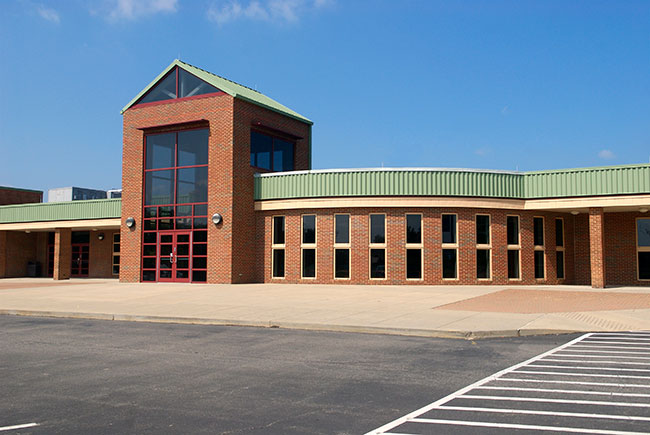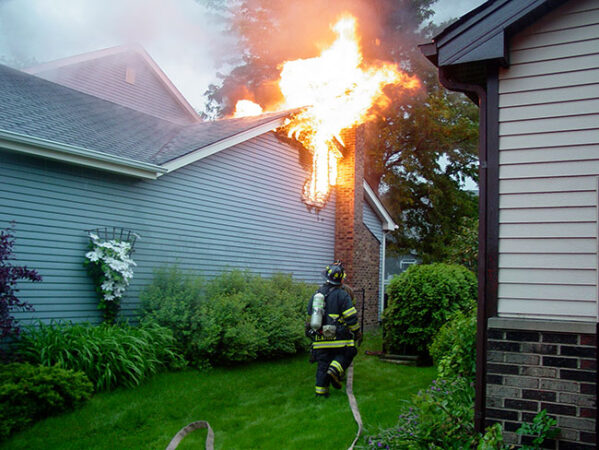
Features
Communication
Training
Trainer’s Corner: Training exercises for better communication in your fire department
April 26, 2024
By
Ed Brouwer
 ABOVE
For a practice night, take your members to three different buildings, for example a public school, seniors’ home and a local business, and do a walk around to start.
PHOTO CREDIT: BGWALKER/GETTY IMAGES
ABOVE
For a practice night, take your members to three different buildings, for example a public school, seniors’ home and a local business, and do a walk around to start.
PHOTO CREDIT: BGWALKER/GETTY IMAGES There are several simple ways to build confidence in your members regarding communicating clearly what they see not only upon arrival, but throughout the fire incident.
Whether you are a rookie or a veteran, the sound of your pager going off releases chemicals in your brain that give you a heightened sense of caution, adrenaline, and anticipation…and even a bit of fear.
It is important to note that this applies not just to you, but every member of your household.
In the mid 1990s three members of our household were volunteering in Joe Rich Fire rescue. It was chaotic when those pagers went off in the middle of the night. There was nothing quiet about my two sons and I heading down the stairs and out the door. My poor wife left behind in the dark, literally and also figuratively in not knowing where we were going or what awaited us when we arrived. There was always an audible sigh of relief when we returned safe and sound.
When a firefighter arrives on scene those chemicals (heightened sense of caution, adrenaline, and anticipation) that the sound of the pager released in their brain are still very much active. Sometimes they can cloud our vision, or worse cause tunnel vision.
If you are the incident commander, your high-viz vest may have two large letters reading “IC” imprinted on the back, but that does not guarantee that you do see. Do you know the importance of what you are looking at? For example, the meaning of the smoke or flame colour. It may be beneficial to review these topics if you are unsure.
The first arriving fire officer or firefighter (paid-on-call) has the responsibility for selecting and putting into action the initial plan. Note I said, “initial” plan. As situations change so should your plan. Stay flexible in your attack plans. Always have a plan “B” worked out before you need it!
It has been said that there are three phases to managing an emergency incident: Panic, Confusion and Remorse. If you are looking for an alternative to those three phases let me suggest: Think, Plan and Act.
The first step is perhaps the most difficult, and that is to think! Someone once told me, “you don’t have time to think at an emergency.” If that is true it proves our need for pre-plans. Pre-planning allows you to become familiar with potential challenges in your fire protection area.
Any time you are out and about in your area, take note of local occupancy types. Look for anything that may present fire ground problems. This type of information filed in the back of your mind may help you identify the problems and solutions while controlling the incident.

For this practice, find four pictures showing houses at various stages of fire involvement.
PHOTO: LINDA SHANNON/GETTY IMAGES
Here is a suggestion for a practice night. Take your members to three different buildings. We were able to use a public school, a seniors’ home, and a local business. I strongly suggest you inform the owners that you are coming.
Do a simple walk around. Do not offer any information regarding what your members should be noting. In fact, say very little, let your members make their own observations. If the owners will let you do a walk through, that would be even better. However, do not spend too long in one place. It should be a quick walk around, and then on to the next place.
When you get back to the fire hall, divide the members into four teams. Have each team choose a note taker and equip them with pen and paper. Then ask them a series of questions such as: What was the street number? What side of the building was the gas meter on? How many entry points were there? Where was the nearest hydrant? Were there any overhead hazards?
These are just a few examples. I am sure you will have no trouble producing a good dozen or so questions. Do this for each of the places you visited. Although some of your members may be long-time residents, they might be surprised at how tough this is. Strange how you can walk by a building and not see what could be of life saving importance.
One of our members asked me, “Do you want us to case the joint?” I smiled and said, “Yes, exactly!”
When you go into a local business look at the floor plan, look for points of egress, or things that could hinder a rescue operation.
Whether full-time, paid-on-call or fully volunteer, there is one universal fire ground challenge that we all need to address, that being communications. It is impossible to competently manage any emergency incident if your fire ground communications are a mess.
The following practice outline could be added to the one above, however I would suggest you take a second night to address the communications issue.
Before the practice find four pictures depicting houses at various stages of fire involvement such as a single-story house with smoke showing but no flames visible, a two-story residence with flames coming through the roof and a single-family residence with flames coming out of the garage. Print them out on separate sheets of paper.
At your practice choose four members to act as dispatch. Take them out of the room and bring them somewhere in the building out of sight and earshot of your remaining members. Divide them into teams of two, one as the note taker the other as the radio operator. Each pair should have one radio (each on a different channel). Just use two members if you cannot work out the different radio channels. Be sure they have some blank paper and a pen.
Inform them that each dispatch team will be given information regarding a fire incident over the radio. Each team is to act as dispatch. One person operates the radio, the other will attempt to draw out (not list) the information as it is presented. (It works better if they think they are in competition).
Now go back to your members (no extra charge for the work-out), and after dividing them into two teams, have each team sit in a row (one behind the other) far enough apart that one team cannot see the picture the other team has. Give the first person in each row a radio and have them go ahead and pair up to one of the dispatch teams in the other room.
Once that has been successfully accomplished, inform the teams that each team member will be given an opportunity to use the radio and act as an IC. When given the radio they are to contact their dispatcher (use proper radio protocol) and describe one thing they see in the picture you are going to give them. Once dispatch acknowledges the message (and does not ask a question), the radio and picture are passed to the next person in line. Now they call dispatch and using proper radio protocol describe one thing they see. This repeats all down the line and if needed it can come back one at a time to the front. Once you have explained it and there are no questions, you begin.
Both teams are going at the same time. To make it challenging, give each team a similar picture but not the same picture. As each team is overheard by the other it may benefit your members to see how that influenced what they saw or thought they saw. The same will hold true for the dispatcher teams. Once you feel there is nothing else to share with dispatch, have the dispatchers return to the room and share their findings. This practice has always proven to generate engagement from our members, and that is golden.
Here is a quick and dirty practice scenario. Visit your local real-estate office and see if you can get some pictures of buildings that have a floor plan attached. Or you may find some online as well.
Simply give each person a picture of the house (front view only). Be sure to keep the floor plan out of their sight. Ask them to draw out on the blank side of the picture what they believe the floor plan to be. Once everyone has completed their floor plans, ask one member at a time to explain how he or she came up with their floor plan. Then hand out the picture of the actual floor plan so they can compare it to theirs. This is a good time to do some old-fashioned brainstorming with questions regarding window sizes, window groupings, venting stakes on the roof, roof lines, attached or detached garages, chimneys, etc.
This sounds easier than it really is. Remind them this type of pre-event knowledge could be a game changer. Knowing where the bedrooms are most likely to be during a middle-of-the-night fire may be the difference between a rescue and a recovery.
Thanks for your time, I would love to join you one practice night, I am sure the coffee would be bad, but the fellowship would be great. Until then, stay safe and remember to train like their lives depend on it. 4-9-4 Ed Brouwer
Ed Brouwer is the chief instructor for Canwest Fire in Osoyoos, B.C., a retired deputy chief training officer, fire warden, WUI instructor and ordained disaster-response chaplain. Contact aka-opa@hotmail.com.
Print this page
Advertisement
- Fire Fighting in Canada This Week – April 26, 2024
- Drawbacks and advantages to seniority-based promotional systems